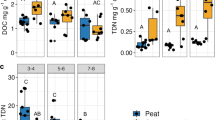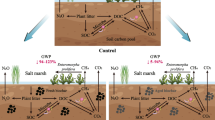Abstract
This study was aimed at examining nitrate (NO3) and phosphate (PO4) removal potentials of rosegold pussy willow (Salix gracilistyla), giant pussy willow (Salix chaenomeloides), Korean willow (Salix koreensis), and bald cypress (Taxodium distichum) from eutrophic aquatic environment. These plants were replanted in rubber pots 35-cm high and 30-cm diameter without holes in the bottom. Water of different concentration levels in NO3 (5, 10, 20 ppm) or PO4 (0.5, 1, 2 ppm) was funneled into the pots, and the residence time of inflow was controlled ranging from 1 to 4 h. Nitrate abatement of 58.9% was observed in the giant pussy willow pots with 20 ppm concentration and 4 h residence. The rosegold pussy willow pots showed the highest PO4 removal at 20.2% at 0.5 ppm concentration and 4 h residence. Removal potentials of NO3 and PO4 were also investigated on the supposition that the polluted water would reside in wetlands or treatment facilities for longer than 5 days. Except that the residence time of inflow ranged from 5 to 20 days, the same experimental conditions were kept. The percentage of NO3 removal in the rosegold pussy willow pots was higher than in those of the other two willow species, and bald cypress showed the lowest NO3 abatement. Highest PO4 removal was observed in giant pussy willow pots and lowest in rosegold pussy willow pots.
Similar content being viewed by others
References
Bowden WB (1987) The biogeochemistry of nitrogen in freshwater wetlands. Biochemistry 4:313–348
Boyd CE (1969) Vascular aquatic plants for mineral nutrient removal from polluted water. Econ Bot 23:95–103
Choi JK (1995) Ecological rehabilitation programs for river environment in cities. J Korean Inst Landsc Archit 22(4):191–197 (in Korean, with English abstract)
Choi GC, Kim NC (1999) Study on the revegetation methods of Phragmites japonica, Miscanthus sacchariflorus, Themeda triandra and Pennisetum alopecuroides for the rehabilitation of close-to-nature river. J Korea Soc Environ Restor Reveg Technol 2(2):70–77 (in Korean, with English abstract)
Craft CB (1997) Dynamics of nitrogen and phosphorus retention during wetland ecosystem succession. Wetl Ecol Manag 4:177–187
Craft CB (2005) Natural and constructed wetlands. In: Anderson M (ed) Encyclopedia of hydrological science. Wiley, New York, pp 1–17
DeBusk WF, Reddy KR (1987) Removal of floodwater nitrogen in a cypress swamp receiving primary wastewater effluent. Hydrobiologia 153:79–86
EPA (U.S. Environmental Protection Agency) (1999) Free water surface wetlands for wastewater treatment: a technology assessment, pp 4-14–4-21. http://www.epa.gov/Wetlands/pdf/FW_Surface_Wetlands.pdf
Faulker SP, Richardson CJ (1989) Physical and chemical characteristics of freshwater wetland soils. In: Hammer DA (ed) Constructed wetlands for wastewater treatment: municipal, industrial and agricultural. Lewis Publishers Inc., Chelsea, pp 41–72
Gersberg RM, Elkins BV, Goldman CR (1983) Nitrogen removal in artificial wetlands. Water Res 17:1009–1014
Ghosh D, Sen S (1987) Ecological history of Calcutta’s wetland conversion. Conservation 14:219–226
Grant RR, Patrick R (1970) Tinicum marsh water purifier. In: Two studies of Tinicum Marsh. The Conservation Foundation, Washington, DC, pp 105–123
Haberl R, Perfler R (1990) Seven years of research work and experience with wastewater treatment by a reed bed system. In: Copper PF, Findlater BC (eds) Constructed wetlands in water pollution control. Pergamon Press, Oxford, pp 205–214
Ham YG (1997) Uptake capacity of heavy metals by water plants. Master Thesis, Graduate School of Soonchunhyang University, Asan, pp 24–27 (in Korean, with English abstract)
Jun MS, Kim BC (1998) Nutrient removal potential of water hyacinth cultured in nutrient-enriched water and swinery wastewater. Korean J Environ Biol 17:117–124 (in Korean, with English abstract)
Kadlec RH, Knight RL (1996) Treatment wetlands. CRC Press, Boca Raton, pp 717–737
Kim YT (1999) A study on the removal of nutrient salt by using aquatic plants. Master Thesis, The Graduate School of Industry, Changwon University, Changwon, pp 1–11 (in Korean, with English abstract)
Kim BY, Kim KS, Park YD (1988) Studies on the nutrient removal potential of selected aquatic plants in the pig waste water. Korean J Environ Agric 7:111–116 (in Korean, with English abstract)
Kim BY, Lee SK, Kwean CS, So KH, Yun EH (1991) Studies on the purification of sewage water by water hyacinth (Eichhornia crassipes). Korean J Environ Agric 10:51–57 (in Korean, with English abstract)
Kwon SH, Ra KH, Lee JH (1996) Aquatic plants for wastewater treatment. Korean J Environ Health Soc 22(3):49–55 (in Korean, with English abstract)
Lee SY (2003a) A study on the water quality upper stream of Dongjin River. Master Thesis, Graduate School of Agricultural Development, Chonbuk National University, Jeonju, pp 30–33 (in Korean, with English abstract)
Lee WJ (2003b) The effect of water purification capacity by native aquatic plants. Focused on Phragmites communis, Sparganium stoloniferum, Alisma canabiculatum and Hydrocharis dubia. Ph.D. Thesis, Graduate School of Sangmyung University, Seoul, pp 62–73 (in Korean, with English abstract)
Licht LA, Iseblands JG (2005) Linking phytoremediated pollutant removal to biomass economic opportunities. Biomass Bioenergy 28(2):203–218
Mitsch WJ, Gosselink JG (2000) Wetlands, 2nd edn. Van Nostrand Reinhold, New York, pp 693–697
Moon YH, Park JM, Son JG, Kim KH (2001) Change in water quality on upper stream of Mankyeong River. Korean J Environ Agric 20(4):252–257 (in Korean, with English abstract)
Park JS (2002) Sewage treatment using water hyacinth (Eichhornia crassipes) and watercress (Oenanthe javanica). Korean J Environ Agric 21:144–148 (in Korean, with English abstract)
Pyon JY, Lee KS, Lee JS (1985) Research report: studies on removal of water pollutants by aquatic plants—1. Removal of organic matter by water hyacinth and factors affecting it’s growth. Korean J Weed Sci 5:143–148 (in Korean, with English abstract)
Reddy KR, DeBusk WF (1987) Nutrient storage capabilities of aquatic and plants. Magnolia Pub., Inc., Orlando
Reddy KR, Campbell KL, Graetz DA, Portier KM (1982) Use of biological filters for treating agricultural drainage effluents. J Environ Qual 11:591–595
Rogers HH, Davis DE (1972) Nutrient removal by water hyacinth. Weed 20:423
Sato H, Kando T (1981) Biomass production of water hyacinth and its ability remove inorganic minerals from water I. Effect of the concentration of culture solution on the rates of plant growth and nutrient uptake. Jpn J Eol 31:257–267
Seo BS, Park CM (2004) Removal effect of nitrogen and phosphorus by growth stage of Iris pseudoacorus L. and storage time of polluted water. J Korean Inst For Recreat 8(3):63–71 (in Korean, with English abstract)
Seo BS, Park CM (2005) Removal effect of nitrogen and phosphorus of Acorus calamus var angustatuson its growth stage and water-storage time. Korean J Environ Ecol 19(1):1–8 (in Korean, with English abstract)
Sim WK, Baek KJ (2000) Landscape materials ecological restoration; development of the close-to-nature construction technology for the low flow revetment of the stream—a case of Jungpyung Stream in Yongin City. J Korean Inst Landsc Archit 28(1):83–91 (in Korean, with English abstract)
Spiels DJ, Mitsch WJ (2000) The effects of seasons and hydrologic and chemical loading on nitrate retention in constructed wetlands: a comparison of low-and high-nutrient riverine systems. Ecol Eng 14:77–91
Sundbald K (1988) Swenden. In: Vymazal J, Brix J, Copper H, Green PF, Green MB, Haberl R (eds) Constructed wetlands for wastewater treatment in Europe. Backhuys Publishers, Leiden, pp 252–259
Vymazal J (2001) Types of constructed wetlands for wastewater treatment: their potential for nutrient removal. In: Vymazal J (ed) Transformations of nutrients in natural and constructed wetlands. Backhuys Publishers, Leiden, pp 1–93
Vymazal J (2002) The use of sub-surface constructed wetlands for wastewater treatment in the Czech Republic: 10 years experience. Ecol Eng 18(5):633–646
Acknowledgments
This work was supported by the Scientific Research Fund of the Agricultural Research and Development Promotion Center in 2001.
Author information
Authors and Affiliations
Corresponding author
Rights and permissions
About this article
Cite this article
Seo, BS., Park, CM., Song, U. et al. Nitrate and phosphate removal potentials of three willow species and a bald cypress from eutrophic aquatic environment. Landscape Ecol Eng 6, 211–217 (2010). https://doi.org/10.1007/s11355-009-0102-7
Received:
Revised:
Accepted:
Published:
Issue Date:
DOI: https://doi.org/10.1007/s11355-009-0102-7




